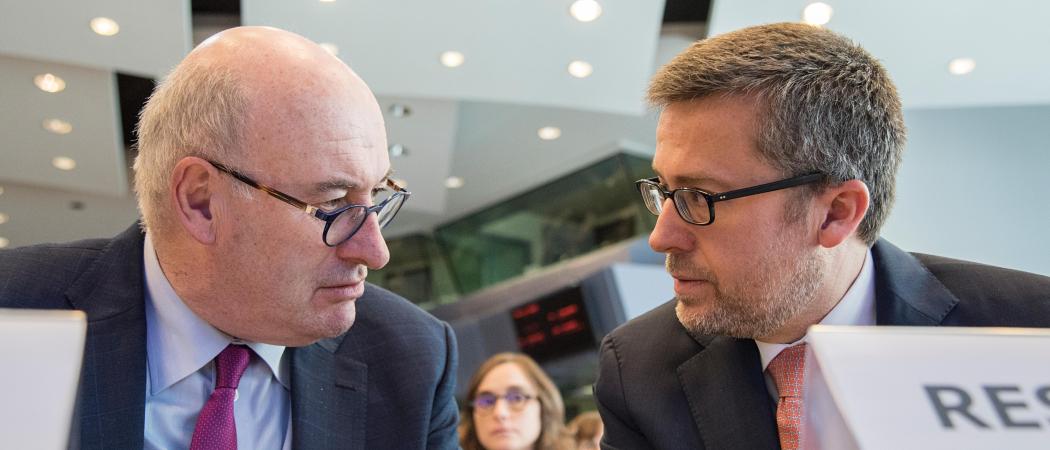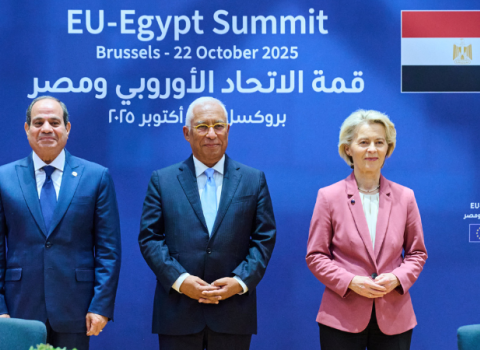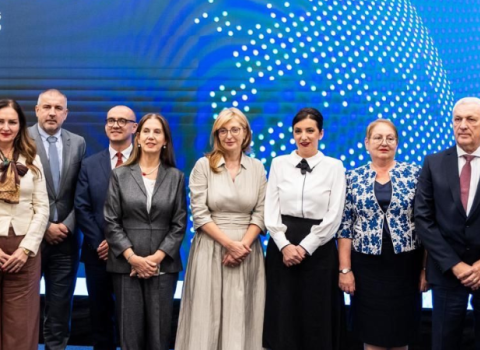Farmers will be compensated for cuts of 5% to direct subsidies by an increased investment in research that will bring agriculture into the digital age, reducing inputs, boosting productivity and improving food safety

EU commissioners Phil Hogan (left) and Carlos Moedas.
Agriculture research is to get a big boost in the 2021 – 2027 budget, with €10 billion to be invested in a collaborative effort to spread the use of big data in farming, to ensure the traceability of foodstuffs and to provide better scientific advice on food safety.
According to the Commission’s budget proposal, the Common Agricultural Policy (CAP) will see a 5 per cent cut in direct subsidies paid to farmers to ensure a safety net, but research dedicated to the sector will rise from €6 billion under Horizon 2020, to €10 billion in the next budget cycle.
That money should be spent on opening up agriculture data, traceability in the food chain and independent scientific advice on food safety, Moedas told the AgriResearch conference in Brussels shortly after the budget proposal was announced.
With this budget, the Commission intends to “innovate the entire food chain” and to invest in areas that are “merging the physical and the digital,” Moedas said.
Speaking at the same event, EU commissioner for agriculture Phil Hogan reinforced this message saying, "We cannot implement the objectives of the CAP without serious investment in research and innovation."
The research and agriculture directorates at the European Commission will work together on drafting a work programme for the budget. Directorates for maritime affairs and environment may also be involved in the process, but it is unclear which of the EU’s agencies will allocate the grants and how.
Big data
The Commission wants to apply data science to overhaul agriculture technologies. “We are lacking the link between agriculture and data,” said Moedas.
Creating that link will open up precision agriculture. As one example of possible applications, the funding could help the EU to install moisture sensors and conduct open data analyses, to fine tune irrigation and reduce the amount of water used on crops. Trigger Systems, a Portuguese start-up is already piloting such a system, and Moedas hopes the model could be applied at EU level.
To achieve this, Moedas said that the new research funding will have to “put the farmer at the centre” and to facilitate access to the latest technologies.
Traceability
As people are becoming more interested in - if not wary of - the provenance of food, Moedas suggested blockchain, the method invented to prevent cryptocurrency fraud, could be applied to ensure consumers have access to more reliable data on the origin of their food.
With blockchain all transactions/movements of food products could be logged in open, distributed ledgers. “Nobody can trick you,” Moedas said.
Blockchain technology could also be used to monitor the use of antibiotics in farm animals. The EU banned the use of antibiotics as growth promoters in 2006, but the evidence is they are still in regular use, fuelling the development of antimicrobial resistance. The European Surveillance of Veterinary Antimicrobial Consumption project collects national-level EU27 statistics, but there is potential to record farm-by-farm use. “We could figure that in seconds with the help of blockchain,” said Moedas.
Scientific advice
Moedas suggested that some money from the new research and innovation budget should be devoted to improving the quality of scientific advice and public communications about food safety. “People are tired today of being told what to do and what is wrong and right,” he said.
The role of scientific advice would be to explain to the public the possible health risks of certain agriculture technologies, for example, the use of the herbicide glyphosate. “If you talk about food or health, you don’t want a doctor to tell you what to do, you want to hear the explanation,” said Moedas.
It is not yet clear whether the ideas suggested by Moedas will be the only areas to be funded from the €10 billion pot.
“We have many synergies planned for the future between the CAP and research and innovation,” said Hogan.
Some money may be allocated to various agri-tech projects the Commission was unable to fund in the past, and also to reduce the cost of adopting these technologies for smaller farms.
“We will sit down with commissioner Moedas and [digital economy] commissioner Gabriel and collaborate to see if we can have a meaningful programme to ensure that smaller and medium sized farmers are able to benefit from agri-tech and precision agriculture,” said Hogan.





 A unique international forum for public research organisations and companies to connect their external engagement with strategic interests around their R&D system.
A unique international forum for public research organisations and companies to connect their external engagement with strategic interests around their R&D system.